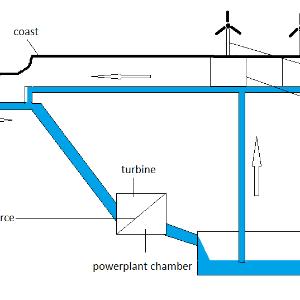 Betsy Agar Aug 19, 2017 02:57 | MIT comments You have hit on one of the must urgent challenges facing our renewable energy future: storage. I live in a hydro-rich region and even here we are shifting our regard for hydro as a source of energy to a means of storage. This is in part due to our realization of the detriments of building new massive hydro plants and also because of advances in harnessing other renewable energy sources. I like that your proposal capitalizes on the resources at hand and attempts to uncomplicated their use: keep water where it is and take advantage of its flow. It reminds me of a related pilot project in Toronto, Canada, which uses compressed air hydro storage (https://www.torontohydro.com/sites/electricsystem/gridinvestment/powerup/pages/compressedairenergystorageproject.aspx). A few thoughts come to mind about this proposal:
I'm really glad there is a storage entry in this contest. |
 Attila Deutsch Aug 20, 2017 02:52 | Proposal contributor Dear Mrs. Agar, thank you very much for taking the time to read and comment on my suggestion to this competition. I appreciate it very much, but this is obviously a misunderstanding. My suggestion is not in the sea but in an underground cavern below the coast ashore. At google under "imgur.com/xCGWilf " I have made a drawing for it which represents my suggestion. So to your first point there is no effect on the coastal and deep water ecosystems since my suggestion is not in the sea. Second point my suggestion does not work with compressed air. To the third point, I mean something different, I`m sorry if my explanations are not clear. I hope I could help them. Thanks for your interest. |
 Betsy Agar Aug 26, 2017 02:43 | Thank you for clarifying. What you are proposing is heavy geotechnical engineering and raises structural concerns about stability and potential for collapse, especially in earthquake prone regions of the world. Have you factored the need for those expertise specific to every region of the world? As well as the costs to ensure stability of a human made cavern with sea water entering and exiting regularly? It also raises questions about freshwater aquifers and water tables, which are also under threat as sea level rises. Perhaps run the plan past some hydrogeologists and hydrologists, especially those who are looking at vertical migration of water between deep and shallow water "bodies" (there is increasing research into this issue at shale gas drilling sites). |
 Chiara Pugnalini Sep 1, 2017 08:26 | Dear Attla, you approached one of the biggest challenge as is storage, which is something that really gets my attention. Even though your idea is very nice I have few doubts about the feasibility. -You mentioned that "The existing electricity networks would not have to have to be used at my proposal. It would be a new independent electricity network". So I wonder how did you consider the redundancy (kind of backup) of the net? In case of some issue how the net will get electricity? -In your picture, I don't see any desalinization of water so as I haven't found it , in the costs. -Installation is limited to coastal areas with presence of cliffs, because otherwise, the drilling would be to expensive Thank you for sharing your proposal. |
 Attila Deutsch Sep 1, 2017 10:09 | Proposal contributor Dear Ms Agar, thank you for yours important comment regarding my proposal. I then inserted a corresponfing addition into my solution. Thanks again for this important objection. For my suggestion, I have oriented on real buildings to get a comparison possibility. Through these successful examples, I am very confident that my proposal is basically realiizable. |
 Attila Deutsch Sep 2, 2017 04:18 | Proposal contributor Dear Ms Pugnalini, thank you for your willingness to read and to comment on my suggestion. The picture is a very simplified representation and serves only to support my explanation. A restriction to coastal areas with a cliff is not necessary. The inlet could be located at aquay wall in a port basin and only need to be constantly below the water line. If my picture was a false impression, I apologize for it. Since I would like to use the sea as a water source for my suggestion, the power plant could be built at depth of less then one hundred meters. So not essentail deeper than most subways in the world (Moscow metro 80 meters deep). In order to reach electricity customers in the country, my proposal would probably need a new electricity network. For the new electricity network I oriented myself on the on power cables which be routed through the Noth Sea and Baltic Sea. The same cables could be routed in artificial as well as natural waterways in the interior of the country in order to reach also electricity consumers and areas behind the coast. My suggestion would have the possibility to use the gained electricity as well as the salt water from the tunnel tubes for desalination. In regions with scant levels of fresh water would this make sense and is also a part of my proposal. But in the general presentation of my proposal I have not consdered this. I have the impression that your think of an Idea that was among other presented by professor Slocum of the MIT. |
 Michal Monit Sep 3, 2017 07:42 | Dear Atilla, First, I really appreciate your holistic approach! Considering items such as mining jobs or renewables working in tandem are a great addition. From the implementation side, you are looking at a very long horizon with optimistic estimates of costs and untested technology. Finally, I think you touch up on a very interesting bit for the future, i.e. crowdfunding energy projects (and the sharing, and co-owning, economy). Have you thought about exploring this avenue further? |
 Attila Deutsch Sep 4, 2017 08:28 | Proposal contributor Mr Monit, thank you very much for taking the time to read and evaluate my proposal. As far as I could, I took your arguments into account in my proposal. |
